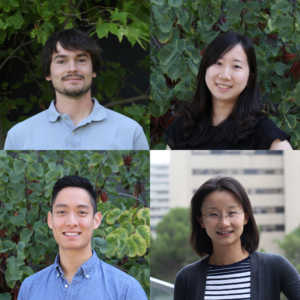
Clockwise from top left: Study authors Casey Brewer, Elizabeth Chu, Rong Lu and Mike Chin (Photos by Cristy Lytal)
Unlike aspirin, bone marrow doesn’t come with a neatly printed label with dosage instructions. However, a new study published in Cell Reports provides clues about how the dose of transplanted bone marrow might affect patients undergoing this risky procedure, frequently used to treat cancer and blood diseases.
In the study, USC Stem Cell researcher Casey Brewer and colleagues in the laboratory of Rong Lu found that transplantation dose affects the behavior of blood-forming stem cells in bone marrow — called hematopoietic stem cells, or HSCs.
To track these cells’ behavior, the researchers “barcoded” individual mouse HSCs with a genetic marker and observed their contributions to forming blood.
Every HSC is capable of acting as a generalist, producing all of the specialized types of blood cells following bone marrow transplantation. However, the researchers observed that only 20 to 30 percent of HSCs took on this generalist role, contributing all of the most abundant types of white blood cells — called granulocytes, B cells and T cells. This relatively small group of generalist HSCs produced a disproportionately large amount of blood.
The remaining 70 to 80 percent of HSCs were more strategic. When facing a scarcity of transplanted bone marrow at the lowest dose, these HSCs prioritized T cell production. At higher transplantation doses, these HSCs opted to differentiate early, producing a balanced array of T cells and B cells.
“The dose of transplanted bone marrow has strong and lasting effects on how HSCs specialize and coordinate their behavior,” said Rong Lu, senior author and assistant professor of stem cell biology and regenerative medicine. “This suggests that altering transplantation dose could be a tool for improving outcomes for patients — promoting bone marrow engraftment, reducing the risk of infection and ultimately saving lives.”
Additional co-authors include Elizabeth Chu and Mike Chin from USC.
The research was supported by a National Institutes of Health grant (NIH-R00-HL113104) and a California Institute for Regenerative Medicine training grant (CIRM-TG2-01161).
By Cristy Lytal